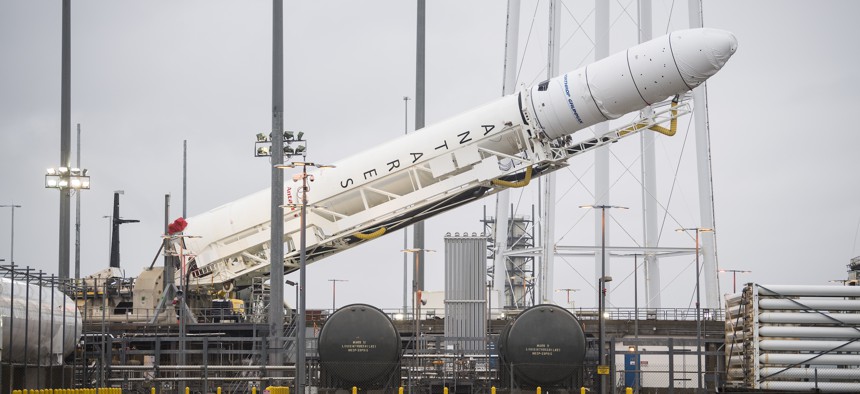
An Antares rocket carrying a Cygnus resupply spacecraft is raised into a vertical position at NASA's Wallops Flight Facility in Virginia, February 5, 2020. Aubrey Gemignani / NASA via Getty Images
Hypersonic Missile Defense May Depend on Low Earth Orbit Satellites
Sensors in relatively low orbits may be the best way to spot superfast missiles—but they can’t do the job alone.
WALLOPS ISLAND, Va.—The Antares rocket that’s launching Tuesday to replenish the International Space Station will be carrying a camera sensor with a unique missile-defense task: to begin gathering data that could help the U.S. more quickly detect and defend against hypersonic missiles.
The Prototype Infrared Payload, nicknamed “PIRPL,” was developed by Northrop Grumman, the Space Development Agency and the Missile Defense Agency to see how low Earth orbit, or LEO, satellites might be used to help detect hypersonic missiles.
“So, tracking layers—looking at missile warning, missile tracking, those kinds of defense-related missions—those are usually done at higher orbits like geostationary orbit, with bigger sensors on longer-life satellites. Sometimes we call them national assets,” said an SDA official who briefed reporters on the condition they not be named.
But geostationary satellites operate at an altitude of 35,000 kilometers from the Earth’s surface, which makes it more difficult to rapidly discern the dim infrared signatures of hypersonic missiles against all the infrared noise, or clutter, generated by the Earth. A low Earth orbit satellite operates at about 1,000 kilometers, “which gives me a ton of better detection capability,” the official said.
“A maneuvering advanced hypersonic missile is not bright and that is why we need to innovate,” the official said.
When a target of interest is identified, the images collected have to be run through a decluttering process to refine out that dim signature.
SDA and MDA have been working toward having a network of low Earth orbit satellites that could speed that detection.
“We have some tough threats out there these days. If we can show we can do those missions at a lower Earth orbit, we are able to get much closer to the source and they look much brighter,” the official said.
But the satellites can’t do the job alone. In order to quickly spot a hypersonic missile’s heat signature, they need to know the existing signatures of the atmosphere, clouds, land, and water as they appear in that low Earth orbit.
“But we don’t have that empirical data,” the official said.
PIRPL will be mounted on a panel on the Cygnus spacecraft riding atop Tuesday’s Antares rocket launch, and once in orbit, begin to collect shortwave and mid-wave infrared imaging data “nearly simultaneous through a rapidly moving filter wheel that will let us understand: ‘What does the atmosphere, clouds, Earth’s surface, land, and ocean all look like at various times of the day and night, from this type of sensor in a low Earth orbit’” to build those data points, the official said.
PIRPL will also be used to help MDA better define what capabilities the future low Earth orbit tracking satellite network will need, the agency said in a statement to Defense One.
“It’s imperative we have the capability to look down on the warm Earth and pick targets out of that scene,” the agency said in a statement. “The Prototype Infrared Payload will help inform MDA’s development of the payload for the Hypersonic and Ballistic Tracking Space Sensor, which is on course for an on-orbit demonstration using two prototype space vehicles in 2023. These space vehicles will demonstrate the unique sensitivity and fire-control quality of service performance necessary to support the hypersonic kill chain.”





